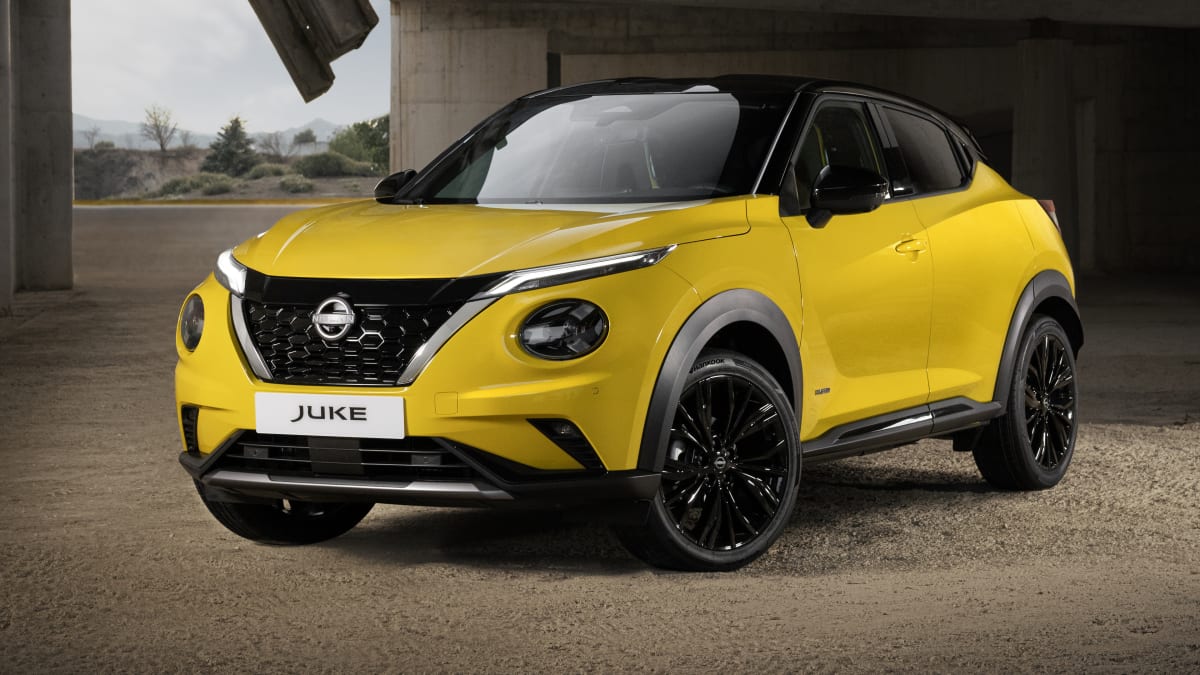The slow-selling Nissan Juke small SUV is set for an upgrade, with larger screens, more safety technology and a revised look.
The Nissan Juke city SUV has received its biggest update since this generation was unveiled nearly five years ago – with a significant interior upgrade – due in Australian showrooms at the end of this year.
It is the mid-life update for what is Nissan’s least-popular SUV in Australia – and the second-slowest seller in the ‘light SUV’ class – with just 1256 Jukes reported as delivered last year, compared to nearly 16,000 Mazda CX-3s.
Australian showroom arrivals are due at the end of 2024, pending any delays. Prices are expected to rise beyond the $28,390 to $36,890 plus on-road costs of the current model introduced here in mid-2020.
Exterior changes are focused on a new yellow paint colour, as Nissan claims “the question we were asked most frequently” by customers since the latest Juke launched was “will there be a yellow one”.
It is said to be paler than the yellow offered on the original Juke – while the black and white paint options have been revised, and there are new alloy wheel designs on more expensive models in Europe.
The most significant changes have occurred inside, where there is now a pair of 12.3-inch screens – for instruments and infotainment – compared to the previous 8.0-inch touchscreen and 7.0-inch driver display with analogue dials of the outgoing model.
The infotainment touchscreen has been tilted by eight degrees towards the driver for easier reach.
It runs Nissan’s latest software with wireless Android Auto now joining carry-over wireless Apple CarPlay, plus improved voice recognition, and in Europe an updated satellite navigation system which now includes speed camera locations and fuel prices.
The digital instrument cluster – as seen in the Qashqai, X-Trail and other new Nissans – offers multiple views, and can display a map between the dials.
There is a new dashboard to accomodate the enlarged touchscreen, plus a reworked centre console with a longer armrest, a slot for credit cards, USB-C ports (in addition to USB-A), and an electric parking brake as standard.
There is now a wireless smartphone charging pad in some models, which Nissan says “can accommodate a smartphone as large as a iPhone 12 Pro Max” – a phone which ended production three years ago.
Other interior tweaks include a larger glovebox (6.6 litres in right-hand-drive versions), USB-A and USB-C rear charging ports, a new “smoother” leather-like steering wheel covering, and new front seats with restyled fabric and leather-look trim.
A new N-Sport variant has been added in Europe, with a black roof, door mirrors, wheels, wheel-arch flares, grille and pillars when specified with yellow exterior paint – plus yellow interior highlights, recycled Alcantara seat inserts, and contrast stitching.
The safety suite has been upgraded with a lane-keep assist system that now appears to be capable of applying steering input to keep the car in its lane, rather than applying the brakes to steer the car back into line. The rear-view camera is now of a higher quality.
There have been no changes to the engine range in Europe, nor the Juke’s suspension.
Australia is expected to remain with a 1.0-litre turbocharged three-cylinder petrol engine, developing 84kW and 180Nm, with a seven-speed dual-clutch automatic transmission and front-wheel drive.
In Europe the 1.0-litre engine develops 86kW/180Nm in Europe – or up to 200Nm on ‘overboost’ – and can be ordered with a six-speed manual transmission.
Overseas a Renault-derived hybrid variant is available, combining a 69kW/148Nm 1.6-litre non-turbo four-cylinder petrol engine with a 36kW/205Nm electric motor and 1.2kWh battery for a 105kW combined power output.
It claims fuel consumption of 5.2 litres per 100 kilometres, 20 per cent better than the 1.0-litre turbo engine.
The 2025 Nissan Juke is now in production in the UK. It is due in Australian showrooms at the end of 2024.
More than 1.3 million examples have been produced globally since 2010, with 16,899 reported as sold in Australia between the original’s launch in 2013, and the end of January 2024 – including about 5800 examples of the latest-generation model.

